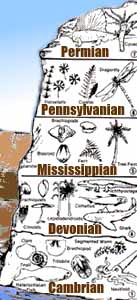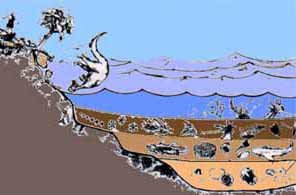 | 

Summary of Scientific Evidence for Creation
VI. The Earth's Geologic Features Were Fashioned Largely by Rapid, Catastrophic Processes that Affected the Earth on a Global and Regional Scale (Catastrophism).
 Catastrophic events have characterized the earth's history. Huge floods, massive asteroid collisions, large volcanic eruptions, devastating landslides, and intense earthquakes have left their marks on the earth. Catastrophic events appear to explain the formation of mountain ranges, deposition of thick sequences of sedimentary rocks with fossils, initiation of the glacial age, and extinction of dinosaurs and other animals. Catastrophism (catastrophic changes), rather than uniformitarianism (gradual changes), appears to be the best interpretation of a major portion of the earth's geology. Catastrophic events have characterized the earth's history. Huge floods, massive asteroid collisions, large volcanic eruptions, devastating landslides, and intense earthquakes have left their marks on the earth. Catastrophic events appear to explain the formation of mountain ranges, deposition of thick sequences of sedimentary rocks with fossils, initiation of the glacial age, and extinction of dinosaurs and other animals. Catastrophism (catastrophic changes), rather than uniformitarianism (gradual changes), appears to be the best interpretation of a major portion of the earth's geology.
Geologic data reflect catastrophic flooding. Evidences of rapid catastrophic water deposition include fossilized tree trunks that penetrate numerous sedimentary layers (such as at Joggins, Nova Scotia), widespread pebble and boulder layers (such as the Shinarump Conglomerate of the southwestern United States), fossilized logs in a single layer covering extensive areas (such as Petrified Forest National Park), and whole closed clams that were buried alive in mass graveyards in extensive sedimentary layers (such as at Glen Rose, Texas).
 Uniform processes such as normal river sedimentation, small volcanoes, slow erosion, and small earthquakes appear insufficient to explain large portions of the geologic record. Even the conventional uniformitarian geologists are beginning to yield to evidences of rapid and catastrophic processes.[19] Uniform processes such as normal river sedimentation, small volcanoes, slow erosion, and small earthquakes appear insufficient to explain large portions of the geologic record. Even the conventional uniformitarian geologists are beginning to yield to evidences of rapid and catastrophic processes.[19] 
|

